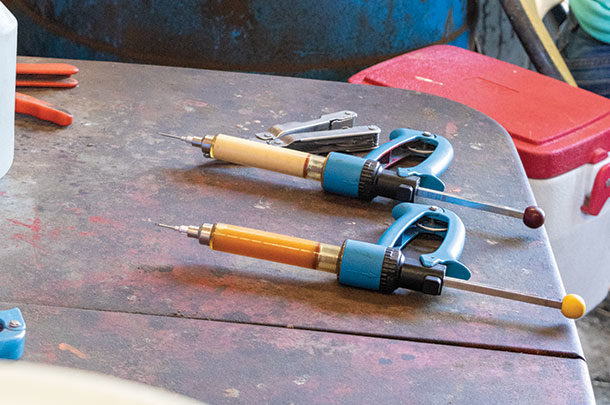Over time, while many aspects of managing cattle have stayed the same, much has changed. New innovations have brought faster growth rates and better performance. The way cattle are fed and cared for has become much more efficient.
As cattle and the way they are managed have evolved, so have the pathogens that impact animal health. Bacteria have changed and adapted to their environment over time, which means the way we prevent, control and treat infections and other diseases that result from bacteria needs to evolve as well. Fortunately, we’ve learned a lot about bacteria, including how they infect cattle and how they create the damage seen in pneumonia.
The leukotoxin-endotoxin effect
You can see how vaccines have upgraded to match the evolution of bacteria by how we’ve addressed the control of Mannheimia haemolytica. While starting the infection in the lung, the M. haemolytica bacteria have a very effective defense system that can destroy the calf’s white blood cells (leukocytes). These leukocytes travel through the bloodstream and get called upon when there is potential for infection.
When M. haemolytica enters a calf’s lungs, it triggers and comes into contact with a leukocyte response. The M. haemolytica bacteria produce a toxin (leukotoxin) that punches holes in the white blood cell, causing it to break open. The leukocyte then releases super-reactive granules carried inside the cell, which activates a larger immune response, resulting in significant inflammation and damage to the lungs. The infection can manifest itself in as few as 36 hours after initial infection and can result in death.
Calves can be especially susceptible during periods of stress, such as weaning, bad weather, heat stress and so forth. Usually, a calf is colonized with bacteria from its dam that live in the calf’s upper respiratory tract but remain inactive until the calf’s immune system is compromised during stress.
The key in creating a vaccine to control M. haemolytica is including enough pure leukotoxoid in the vaccine to initiate a protective antibody response. Antibodies created by the calf will bind to the leukotoxins and render them nontoxic. That way, when M. haemolytica invades the lungs, the leukotoxins it creates do not kill the white blood cells, allowing them to do their job attacking the invading pathogen: M. haemolytica.
Generating protection against the leukotoxin M. haemolytica is the most important aspect of creating effective immunity against this major pathogen. Just like when leukotoxins break open white blood cells to release cellular contents and initiate infection and immune response, the contents of gram-negative bacteria found in the cell wall can release material called endotoxins that can cause significant illness. Gram-negative bacteria contain a thick outer capsule containing lipopolysaccharides (endotoxins) that when released can have a profound, negative impact on animal health.
Because of the way some vaccines are manufactured, endotoxins can easily end up as part of the vaccine as well. Bacterial vaccines are made by a fermentation process. During this process, bacterial cells can be ruptured or broken open, resulting in the release of endotoxins found in the cell wall of the bacteria.
Nearly every vaccine contains endotoxins at some measurable level. Cattle become more susceptible to the effects of endotoxins when several gram-negative vaccines are used at once. This stacks the endotoxin effect and substantially increases the risk of an adverse reaction. These reactions can vary from shocklike symptoms to abortion, fever, anorexia, hypotension and even mortality.
Again, as with leukotoxin control, it matters which vaccine you use when it comes to avoiding the impacts of endotoxins. As mentioned, the vaccine production process can result in a heavy load of endotoxin when the fermentation process is going on. There are vaccines that go through a different manufacturing process that includes only a portion of the bacterial cell.
We do need the vaccine to stimulate the calf to develop antibodies to the outside of the bacteria as well as the leukotoxin. It would be nice if we could have the antibodies made for the cell wall with minimal levels of endotoxin.
Think of the bacteria as a basketball. Instead of using the whole outer shell of the basketball, just the dimples of the basketball’s surface are used to manufacture the vaccine. That means far fewer endotoxins are captured in the manufacturing process, and producers can use specific vaccines with other gram-negative vaccines for a potential for reduced risk of endotoxin shock because the endotoxin levels are vastly lower than some other gram-negative vaccines.
Vaccine handling
Sometimes, the way producers handle vaccines can increase endotoxin levels. Here are a couple of tips for proper handling:
- Don’t shake; roll. Often, the first thing producers do when they get a vaccine or even an antibiotic is shake the bottle to mix the contents. In old-school products like penicillin, this was common practice to ensure contents of the bottle were mixed together. However, vigorous shaking can break open cell walls and release endotoxins. Instead, gently roll the bottle to combine ingredients, if any precipitate is at the bottom of the bottle.
- Don’t freeze. The same issue related to breaking cells open occurs when vaccines freeze. Ice crystals formed inside cells have very sharp edges. During the freezing and thawing process, ice crystals break open cells and can release endotoxins into the vaccine. It’s OK to cool the vaccine, but don’t let it freeze.
o Remember the environment where the refrigerator is located, especially in cold climates where refrigerators could be in unheated shops. When the temperature falls to well below freezing, the contents in the refrigerator will drop that low as well, causing the freezing situation.
- Avoid vaccinating young calves. When calves are born, they need every bit of fat and energy just to stay alive and survive, especially when it’s cold and rainy outside. The last thing they need is a vaccine that causes them to divert energy and resources to building antibodies. If calves have had adequate levels of colostrum to accomplish passive immunity, producers have plenty of time to administer a vaccine and still accomplish protection. Wait to vaccinate calves until they’re bigger and the weather is nicer.
The industry has learned a lot about how bacteria cause disease in cattle. The manufacturing process for vaccines has evolved alongside bacterial changes to keep up with prevention mechanisms that help cattle avoid disease. In addition to beneficial manufacturing practices, proper vaccine handling and administration techniques can help as well. To discuss questions about leukotoxins, endotoxins and vaccines to help avoid these negative impacts, consult with your herd veterinarian.










